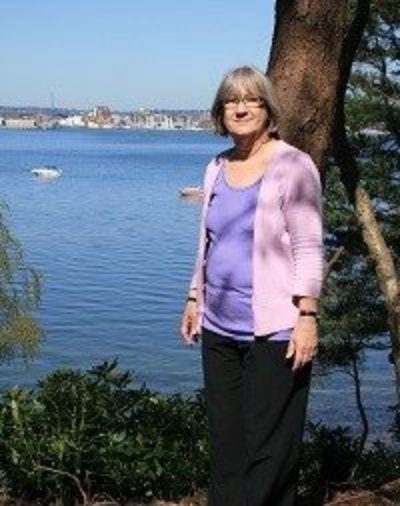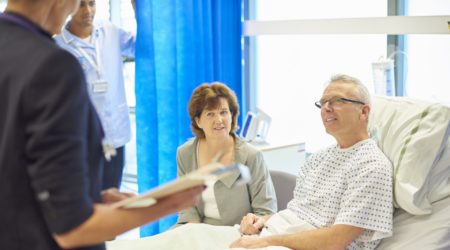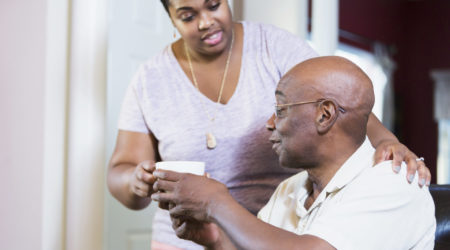



Anne
Anne was diagnosed in 2009 with an intraductal papillary mucinous neoplasm (IPMN), and in 2010 with a malignant IPMN in the head of the pancreas.
Anne updated her story in August 2017
Well here I am in an ambulance with siren going and blue light flashing. I had collapsed in terrible pain at school – I was a science teacher. My story started then, in 2002.
A diagnosis of chronic pancreatitis
A succession of scans and tests followed: ERCP, EUS, CT, MRCP, blood tests for amylase, CA19-9. Scans implied a stricture of the pancreatic duct towards the ampulla. For the next four years I was in and out of hospital suffering horrendous pain attacks and chronic pancreatitis was diagnosed.
Twice I had stents inserted and my gall bladder was removed as a palliative measure. Flare-ups were always preceded by steatorrhoea for which I took Creon.
After another two years I was referred to hospital. A tumour – an IPMN (intraductal papillary mucinous neoplasm)- was suspected and over the next year it was proved to be the cause of my pancreatitis.
A CT scan showed worrying signs
My main pancreatic duct became wider and wider over the course of my illness and the rate of increase became much greater in late 2008/early 2009. It was then 15mm in diameter (normally about 2mm) all the way along and mucus was seen in the duct. The common bile duct was also dilated.
In February 2009 a CT scan showed “worrying signs”. I was very scared! At the time I was incredibly tired with some pain – but was using patches and dihydrocodeine to control this. My pancreatic symptoms were variable, sometimes lots of pain with the need for Creon and other times not too bad. It depended how blocked the duct was. It seemed to block, pressure would build up with pain and circulating enzyme problems and then diminish. Scans and tests showed an IPMN in the main pancreatic duct. The double duct sign and the fact that it was a main duct tumour was highly indicative of malignancy. IPMN’s are potentially malignant tumours and are likely to progress to adenocarcinoma.
My first surgery
I was advised that the pancreas needed to come out. So in April 2009 I was scheduled for a distal pancreatectomy and splenectomy. The spleen and the distal end and the body of the pancreas were removed. This removed the tumour and surrounding tissue. The surgeon had a good look round the head of the pancreas but decided to leave it in at present but suggested it might have to come out later. The head was damaged with chronic pancreatitis but still producing sufficient hormones to keep diabetes at bay, my blood sugar was steady in the hospital and within normal limits. The histology report showed that the tumour had borderline malignant potential but local lymph nodes were clear so the team seemed confident that they had done enough during the surgery.
A year later, I felt pretty well most of the time. My pain had gone completely during the first few months after the operation and my digestive system was working well with the help of a little Creon with meals. I wasn’t diabetic so the third of a pancreas I had left seemed to be doing a good job. I take penicillin because of the loss of the spleen and Omeprazole to keep the stomach acid down.
Whipple’s procedure
Unfortunately, in spring 2010, a recurrence of symptoms began. Dull, aching pain and intermittent steatorrhoea started to get me worried. I had an appointment in May and a CT scan was arranged. The dilated pancreatic duct raised suspicions and a raft of the usual tests led to the conclusion that another IPMN had appeared in the head of the pancreas and appeared malignant. A Whipple’s procedure was arranged and this took place in December at a different hospital.
I’m four months post-op now and making a good recovery. I can cope with the digestive problems using Creon and am learning to cope with the diabetes although am having some highs and lows.
The histology report showed adenocarcinoma in the head of the pancreas as a focus within the IPMN. My surgeon seemed very relieved that he had done a curative operation. The lymph nodes had been clear which was a relief and I haven’t had chemotherapy.
I’m so grateful to the teams at my hospitals. The treatment has been excellent and everyone inspired confidence. I’m just glad to be alive and enjoying life with my wonderful family.
April 2011
Update July 2012
It’s nineteen months now since my second surgery – nineteen months with no pancreas and I’m doing fine.
I won’t say everything is wonderful, it’s quite difficult to manage the diabetes sometimes and I have to make sure I take sufficient Creon to deal with steatorrhoea; penicillin because of the lack of a spleen; and Omeprazole to reduce stomach acid.
I sometimes get an awful pain where the pancreas used to be, but it is rare – only once every few weeks and it soon stops. The consultant says it might be adhesions and not to worry.
I’ve been scanned every three months because an early scan showed a lung nodule and some enlarged lymph nodes. These have mainly settled and just one node is enlarged but is not thought to be worrying.
I do get tired and can’t be spontaneous about going out for example. Sometimes I just have to say I can’t make it but everyone understands.
Life is good with Alan and the children and grandchildren. I retired in 2006 but the family keeps me busy and we have recently had our son’s wedding. We’ve also had two new babies in the family since my surgery and I’m so pleased the surgeons made it possible for me to be here for these events!
All in all, the outcome of the two surgeries has been a good one and I’m very lucky that the IPMN’s gave me pancreatitis so that they were monitored regularly and dealt with as soon as they started to look threatening.
It is definitely possible to live a good life without a pancreas – if at a slower and more considered pace.
Update August 2017
Five More Years
Nearly five more years have gone by since I had my Whipple’s and six and a half since the distal pancreatectomy to remove the two malignant IPMNs.
Well my diabetes is pretty well controlled and my digestion OK with the help of about eighteen 10,000 unit Creon capsules a day. Living without a pancreas isn’t easy but is manageable. My problems are occasional “Whipple attacks”, i.e. intense epigastric/sub-costal pain which is quite debilitating for a while. Also I sometimes get attacks of rigors and nausea which can last a night and lay me low for a couple of days, these are rare, though, only once every couple of months.
Looking back, I am so pleased for the early diagnosis of these tumours. It was because they gave me pancreatitis that they were discovered and dealt with!
Since I lost my pancreas I have continued to enjoy life. My husband and I go on quite few short breaks, the last to Bruges. Our younger son is a drummer and we go to a lot of his gigs. We have had two weddings in the family in the last five years and three new grandchildren. Our older son and his partner live in Berlin and we go and visit them quite regularly. They have a baby on the way – due next month – so we’ll be off again. With our two older grandchildren and their mums and dads we are kept quite busy and entertained!
I am eternally grateful to the excellent teams at my hospitals who made it possible for me to still to be part of all this and also very hopeful for the future.




